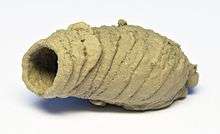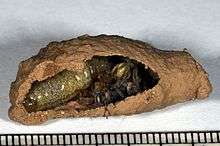Sceliphron curvatum
| Sceliphron curvatum | |
|---|---|
 | |
| Sceliphron curvatum | |
| Scientific classification | |
| Kingdom: | Animalia |
| Phylum: | Arthropoda |
| Class: | Insecta |
| Order: | Hymenoptera |
| Family: | Sphecidae |
| Genus: | Sceliphron |
| Species: | S. curvatum |
| Binomial name | |
| Sceliphron curvatum (F. Smith, 1870) | |
Sceliphron curvatum is an insect of the Sceliphron genus, of the Sphecidae family of wasps. Like all wasps of this genus, it is a solitary species and builds nests out of mud. S. curvatum is native to some regions of Asia and invasive to Europe.
Description

Sceliphron curvatum is 15 to 25 millimetres (0.6 to 1.0 in) long and is coloured black with yellow and red ornaments. It builds nests of mud on the walls of buildings but also very often indoor on piles of books, clothes or pieces of furniture. Every nest is filled with paralyzed spiders, which serve as food for the larvae. Like all Sceliphron species, S. curvatum is not aggressive unless threatened.
Distribution

Formerly, the species was distributed in India, Nepal, Pakistan, Kazakhstan and Tadjikistan in submontaneous regions at the highest mountain ranges of the world: Himalayas, Karakoram and Pami. It was first recorded in Europe in 1979 when a female was collected near the village Grätsch in southeastern Austria. It is assumed that S. curvatum was introduced to Europe as a result of human activity but after that the species has been spreading throughout Europe at most itself. Since 1979 the species has expanded to other European countries: Slovenia, Italy, Croatia, Switzerland, France, Hungary, Germany, Serbia and Montenegro, Greece, Czech Republic, Spain, Slovakia, Ukraine and Romania. S. curvatum has been quickly enlarging its area in Europe and forming mighty populations in antropogenous localities (towns, villages) in southern and central Europe.
References
- P. Bogush, P. Liška, J. Lukáš & A. Dudich (2005). "Spreading and summary of the knowledge of the invasive sphecid wasp Sceliphron curvatum (Smith 1870) in the Czech Republic and Slovakia (Hymenoptera: Apocrita, Sphecidae)" (PDF). Linzer Biologische Beiträge. 37 (1): 215–221.